
Home to one of the world’s oldest continuous major civilizations, with historical and urban settlements dating back to 7000 BC, Iran seeks to attract more foreign travelers, and in particular, vacationers from China. Iran’s deputy tourism minister on Wednesday stressed the need for all-inclusive fault detection, and identification of effective factors to expand tourism ties with China in a meeting with travel experts from the state-run institutes and the private sector. We should pay attention to the Chinese market in a more pragmatic approach,” Ali-Asghar Shalbafian said in the follow-up session held to formulate new strategies to expand tourism cooperation between the two ancient countries. So far, steps have been taken to examine the Chinese tourism market, but today the (essential) need is to implement executive measures based on [our] fault detection and macro planning,” the official noted. Insignificant numbers of Chinese restaurants, Chinese-language guides, or even inappropriate lodging facilities are deemed to be among the main reasons why Chinese arrivals in Iran fall short of expectations. Some experts believe that part of this failure comes from inside Iran because Chinese restaurants are scanty across the country while the cuisine is of high importance for the majority of the Chinese people. Moreover, Chinese travelers need fluent Chinese-language tour guides whose numbers are limited in the Islamic Republic. Last year, Tehran’s ex-ambassador to Beijing said Iran was seeking to become a tourist destination for millions of potential travelers from China as the two countries are working on a 25-year comprehensive cooperation plan that includes boosting relations in the field of tourism. Speaking in the TV program, Mehdi Safari reminded some 200 million Chinese tourists to visit different countries annually, adding “according to this agreement Iran will become one of the tourist destinations for Chinese travelers so that Iran can attract one to two million Chinese tourists to the country.” This will create a transformation in Iran’s tourism industry and will create jobs and a large market for the handicrafts industry of the country,” he expanded. In 2019, the Islamic Republic waived the visa requirement for Chinese nationals willing to visit the country. The decision was made to attract more foreign tourists to the country; however, it was a unilateral measure, because Iranian tourists visiting China still need visas. Under the 2025 Tourism Vision Plan, Iran is expecting to increase the number of tourism arrivals from 4.8 million in 2014 to 20 million by 2025.
Create: Nov 9, 2021 Edit: Nov 9, 2021 Regional News
The Federal Communications Commission has authorized a satellite internet project from Boeing first proposed in 2017. Boeing can now move forward with building, launching, and operating its own broadband internet network from space, joining its main aerospace competitor SpaceX. Boeing’s plan involves placing 132 satellites into low Earth orbit at an altitude of 1,056 kilometers (about 656 miles). Another 15 will be launched to “non geostationary orbit” at an altitude between 27,355 and 44,221 km (16,998 to 27,478 miles). The company says it wants to use the satellites to offer “broadband internet and communications services to residential consumers, government and business users in the United States, Puerto Rico and the US Virgin Islands” while the network gets built out, and on a global basis once it’s complete. All 147 satellites would broadcast in the V-band, a higher-frequency slice of the wireless spectrum than the Ka and Ku bands used by SpaceX’s Starlink network or Amazon’s yet-to-be-deployed Project Kuiper satellites. Using V-band could allow for faster data transfer rates but runs a greater risk of interference because the higher frequencies have more trouble penetrating solid objects. (SpaceX has plans to use the V-band in some future satellites, and so does OneWeb. The Ka and Ku bands are also used by satellites that provide in-flight internet on commercial airlines.) SPACEX HAD TOLD THE FCC IT WAS CONCERNED BOEING’S NETWORK WOULD CROWD LOW EARTH ORBIT SpaceX has previously expressed concern that Boeing’s proposal to launch into already-crowded low orbits could increase the risk of a collision with other satellites. In 2019, SpaceX said to the FCC that it believed Boeing’s network would create a “clear danger of harmful interference,” according to Reuters. SpaceX’s Starlink satellites orbit the Earth at an altitude of around 550 km (roughly 342 miles), which is around where OneWeb’s internet satellite constellation can be found (and where Amazon’s satellites will go once they launch). SpaceX and OneWeb narrowly avoided a collision earlier this year. Boeing now has six years to launch half of its satellite constellation and nine years to deploy the entire network. The company had asked the FCC to loosen those requirements — it wanted to only commit to launching five satellites in the first six years, and asked for a 12-year window to launch the entire constellation — but the commission denied that request, according to the order published Wednesday. By comparison, SpaceX and Amazon have far grander plans for their networks, with each consisting of thousands of satellites. Boeing is a major satellite manufacturer, and so it spent the years before and after its initial 2017 proposal selling to early space-based internet providers as the market matured. But providers are now expected to collectively generate more than $50 billion by 2031, which could explain why Boeing bothered slogging through four years of the approval process.
Create: Nov 5, 2021 Edit: Nov 5, 2021 International News
Three Qajar-era (1789-1925) caravanserais in Tabas, eastern South Khorasan province, have recently been demarcated help their legal boundaries and properties, a local tourism official has said. “New boundaries have been defined for Khan, Chehel Payeh, and Deh-e Mohammad caravanserais in a bid to curb illegal constructions within their boundaries,” Parisa Jamshidi announced on Sunday. The caravanserais, which are among the candidates for a collective inclusion in UNESCO’S cultural heritage list, has been recently restored, the official noted. Over 70 billion rials ($1.7 million at the official exchange rate of 42,000 rials per dollar) has been invested in the restoration projects of the historical inns so far, she added. Caravansary (also Caravanserai or Caravansaray) is a building that served as the inn of the Orient, providing accommodation for commercial, pilgrim, postal, and especially official travelers. According to Encyclopedia Iranica, from the number of surviving caravansaries and their sizes, it is clear that in Safavid and Qajar times there was a state architectural department that was specifically concerned with the construction of caravansaries and stations on the overland routes. Furthermore, in the cities, several caravansaries were erected as lodging houses, depots, and commercial offices in the vicinity of the bazaars. A typical caravansary consists of a square or rectangular plan centered around a courtyard with only one entrance and arrangements for defense if necessary. Whether fortified or not, it at least provided security against beasts of prey and attacks by brigands. Iran’s earliest caravanserais were built during the Achaemenid era (550 -330 BC). Centuries later, when Shah Abbas I assumed power from 1588 – to 1629, he ordered the construction of network caravanserais across the country. Such roadside inns were originally built in various epochs along ancient caravan routes in the Muslim world to shelter people, their goods, and animals. The former Silk Roads may be the most famous example dotted by caravanserais.
Create: Nov 3, 2021 Edit: Nov 3, 2021 Regional News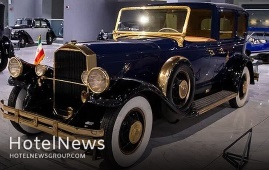
Following years of restoration and renovation, Iran Historical Car Museum in western Tehran has reopened its doors to the public, featuring a magnificent collection of rare classic, vintage, sports cars, carriages, and motorcycles.Highlights of the museum include a gold-plated limousine, the world’s only Panther-Laser car produced, a Silver Ghost Rolls-Royce once owned by the Qajar King, Ahmand Shah (r. 1909 – 1925), as well as a royal carriage belonging to Nasereddin Shah of Qajar.In an interview with the Tehran Times on Sunday, the director of the museum Mohammad Fa’al, said: “The 1922 Rolls-Royce, a Morris Oxford Bullnose, and a Fiat Tipo 519 constitute the three oldest cars of the collection.”“The building of the museum underwent restorations as of 2005 as you can see the images of the restoration of the building and cars have been installed on the walls of the museum. Moreover, we refurbished a dozen other cars from our treasury and added them to the newly-opened museum.”“The museum has four main halls, the first of which bears the oldest vehicles of the collection, amongst them the Rolls-Royce Silver Ghost that was belonging to Ahmad Shah Qajar,” he said. Hall 2 is dedicated to American and Mercedes-Benz vehicles, and Hall 3 is devoted to the official and ceremonial cars, which include various models of Rolls-Royces and Mercedes. Hall 4 is also dedicated to sports and super sports cars. In response to a question about the number of vehicles, the director said: “There are currently 102 cars in the treasury in addition to 55 cars that are currently on display.” “Of course, what you now see in here is not all our cars, and we have a treasury that acts as a support for the museum, and it has cars that are being renovated over time and replaced with these existing cars in order to preserve the charm of the museum.” The museum owns the largest collection of Mercedes-Benz 600 in the world. “We have the largest collection of Mercedes-Benz 600 in the world with 21 units. The Mercedes-Benz Museum itself has three units of the 600 model…. the Mercedes-Benz 600 itself is designed and built with different rooms and its function is only for ceremonies and this model has different rooms some having hardtop or custom-made sunroofs,” the director of the museum explained. He said that the museum owns all models of Mercedes-Benz 600, which is very unique. “Moreover, we have all models of Mercedes-Benz 600 that have been produced by the German company; four of which are on display here in the museum, and 17 are being kept inside the treasury.” Furthermore, Fa’al added 21 classic Rolls-Royces are being kept in the museum and its treasure trove. “Home to 21 [classic] Rolls-Royces, Iran Historical Car Museum is the second-largest treasure trove of those vehicles after the Rolls-Royce Museum.” Talking about the values of cars he explained, “all these cars are valuable and it is impossible to say which one is better. We can say which one is more beautiful and which has a more attractive design, but we cannot say which is more valuable.” “However, the classification of cars in terms of value depends on several factors: one is the age of the car, the other is its manufacturer brand and design technology. And there are decorative items used in cars. For instance, a car in which is gold plated and is decorated with jewelry is obviously more valuable than an ordinary one….” Responding to a question concerning restoration, Fa’al said all the processes of rebuilding cars are fully documented and all phases are photographed and evidence is available. The age of the classic cars According to Brinatica, the decade 1925–35 was notable not only for the appearance of many new small automobiles but also for the building of many ultra-large ones. The years from 1925 to 1948 are cited by collectors of automobiles as the “classic years,” a period that saw the rise of the luxurious fast motorcar to a peak it seems unlikely to reach again. The first name in this field was Rolls-Royce Ltd., founded in 1906. Most Rolls-Royce chassis are designed for limousine and large sedan bodies, but the firm once made a comparatively light car (called the Twenty), and it has throughout its history produced fast models in addition to its regular line—e.g., after World War II, the Continental, built under the Bentley Motors Ltd. label. Other motorcars of this type included the Hispano-Suiza of Spain and France; the Bugatti, Delage, Delahaye, Hotchkiss, Talbot (Darracq), and Voisin of France; the Duesenberg, Cadillac, Packard, and Pierce-Arrow of the United States; the Horch, Maybach, and Mercedes-Benz of Germany; the Belgian Minerva; and the Italian Isotta-Fraschini.
Create: Nov 3, 2021 Edit: Nov 3, 2021 Regional News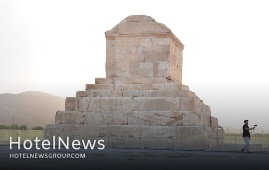
Iranian government has allocated a sum of 200 billion rials (about $4.7 million at the official exchange rate of 42,000 rials per dollar) to develop tourism infrastructure at the UNESCO-designated Pasargadae. A budget of 200 billion rials has been allocated to Pasargadae after President Ebrahim Raisi visited the Achaemenid site earlier in October, a senior tourism official, Javad Vahedi, said on Friday. The Pasargadae complex, as a magnificent World Heritage site, has a high tourism potential in the field of cultural and historical tourism, and we must plan to attract more tourists,” the official explained. Situated about 50 km north of Persepolis, Pasargadae was the first dynastic capital of the Achaemenid Empire, founded by Cyrus II the Great, in Pars, the homeland of the Persians, in the 6th century BC. Its palaces, gardens, and the mausoleum of Cyrus are outstanding examples of the first phase of royal Achaemenid art and architecture and exceptional testimonies of Persian civilization. The UNESCO World Heritage site is also home to a complex water supply system for the time that comprises cisterns, tunnels, underground canals, and ducts, which are locally known as qanats. It is believed that the development of qanats began about 2,500 or 3,000 years ago in Persia (Iran), and the technology spread eastward to Afghanistan and westward to Egypt. Although new qanats are seldom built today, many old qanats are still used in Iran and Afghanistan, chiefly for irrigation. The 160-ha archaeological site of Pasargadae presents some of the earliest manifestations of Persian art and architecture. It includes, among other monuments, the compact limestone tomb on the Morgab plain that once held Cyrus the Great’s gilded sarcophagus; Tall-e Takht (“Solomon’s Throne”), a great fortified platform built on a hill and later incorporated into a sprawling citadel with substantial mud-brick defenses; and the royal ensemble, which consists of several palaces originally located within a garden layout (the so-called “Four Gardens”). Pasargadae became a prototype for the Persian Garden concept of four quadrants formally divided by waterways or pathways, its architecture characterized by refined details and slender verticality. Pasargadae stands as an exceptional witness to the Achaemenid civilization. The vast Achaemenid Empire, which extended from the eastern Mediterranean and Egypt to the Hindus River in India, is considered the first empire to be characterized by a respect for the cultural diversity of its peoples. This respect was reflected in the royal Achaemenid architecture, which became a synthesized representation of the empire’s different cultures. Pasargadae represents the first phase of this development into a specifically Persian architecture which later found its full expression in the city of Persepolis.
Create: Oct 31, 2021 Edit: Oct 31, 2021 Regional News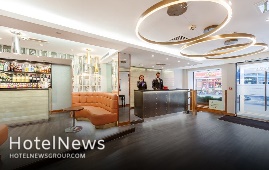
Cycas Hospitality, the award-winning pan-European operator, has signed a deal to operate London Town Group’s portfolio of upscale boutique hotels in the UK capital. The London Town Group of Companies, founded by Koolesh Shah, is one of the UK’s leading, privately-held real estate and energy investment companies. The agreement sees Cycas welcome its first two Mercure-branded hotels – part of Accor – to its portfolio. While the 72-room Mercure London Hyde Park – set within a Grade II listed building – recently completed a multi-million-pound refurbishment, the 86-room Mercure London Paddington is scheduled to start a fully renovation programme next year. As part of the extensive works, the hotel will upgrade its ground floor food and beverage facilities and transform its top floor into a rooftop bar.As Cycas’s seventh IHG-branded property, the 64-room Hotel Indigo London Paddington becomes its first Hotel Indigo in London and joins Hotel Indigo Dundee as its second in the UK. All three properties offer a wide range of dining options, meetings facilities and state-of-the-art fitness centres, all just a short walk from Hyde Park and Paddington Station, whose access will be further boosted with next year’s opening of Crossrail and the Elizabeth Line. Cycas has appointed Tanja Furby as Cluster General Manager for the three London hotels. A seasoned operator who has worked across a wide range of leading hospitality brands, Tanja’s commercial skills, leadership and local knowledge will help Cycas maximise each property’s customer offering. Koolesh Shah, Founder of London Town Group, said “As our business diversifies and grows, I felt now was the time to bring on board a recognised industry leader in hotel operations to partner on the transformation journey of our hotels. “We’ve always prided ourselves on our collection of leading branded-boutique hotels, and we’re confident that Cycas’s track-record in delivering the highest hospitality standards will ensure we can continue to give our guests the best possible experience.” Matt Luscombe, Chief Executive Officer at Cycas Hospitality, said: “I’ve known and admired Koolesh and his team for many years, since he opened the first Hotel Indigo outside of North America in 2009. Over the last decade, London Town Group has been synonymous with commercial and operational excellence. “With their central locations and exceptional transport links, these three hotels are ideally positioned to capitalise on the recovery in business and leisure travel. We’re proud and excited to begin this partnership together. The deal follows continued expansion for Cycas Hospitality, which has now opened or taken over 17 hotels in 12 months, despite the challenges posed by the Covid-19 pandemic,
Create: Oct 31, 2021 Edit: Oct 31, 2021 International News
The Ritz-Carlton Hotel Company, L.L.C. is excited to announce the debut of The Ritz-Carlton, Mexico City, providing discerning travelers with a new way to discover one of the world’s most dynamic destinations. Transforming the city’s skyline and sitting amongst the country’s tallest buildings, the hotel is centrally located along the iconic Paseo de Reforma and showcases uninterrupted views of the famed Chapultepec Park. Featuring the legendary service of the brand’s Ladies and Gentlemen, each detail of the hotel is thoughtfully designed to immerse guests in the city’s rich culture and offer a unique perspective on this beloved destination. Featuring unparalleled service, The Ritz-Carlton, Mexico City celebrates legendary Mexican hospitality and offers guests a highly personalized experience. The hotel features a wide range of carefully curated amenities designed for cultural discovery and epicurean adventures or business travel, including The Ritz-Carlton Club® Lounge with an exclusive Club Concierge, a heated indoor swimming pool, large fitness center with state-of-the-art equipment and a signature Ritz-Carlton Spa with six luxurious treatment rooms. Bringing the destination to life in a unique way, The Ritz-Carlton Spa thoughtfully sources local ingredients and botanicals, which are then coupled with the healing and spiritual traditions of Mexico City’s Aztec culture. In addition to relaxing and rejuvenating treatments, the spa features an assortment of wellness areas, including steam rooms, saunas, and a timeless capsule room. Dining at Samos, the Mediterranean inspired restaurant on the 38th floor of The Ritz-Carlton, Mexico City, guests can enjoy cuisine featuring dynamic local flavors for a one-of-a-kind experience. Bringing vast luxury experience and expertise in Mexican, Italian, French, Peruvian and Argentinian cuisines, Chef Jonathan Felix has carefully created each dish to offer a culinary journey where flavors and sensations are elevated with every bite. The epicurean experiences continue through the dessert course with delicate sweets like Nido, an airy mango and passion fruit mousse encased in white chocolate and cradled by a spun sugar nest. The Ritz-Carlton, Mexico City also offers more than 4,300 square feet of meeting space with floor to ceiling windows overlooking Chapultepec Park, ideally suited for a variety of events from meetings to celebratory occasions. The spaces have been designed to foster inspiration and connection whether a large gathering in the ballroom or an intimate board meeting.
Create: Oct 31, 2021 Edit: Oct 31, 2021 International News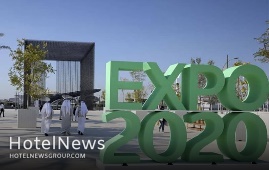
A selection of craftspeople, travel insiders, and exhibitors from Sistan-Baluchestan are getting prepared to promote the southeastern Iranian province at the Expo 2020 Dubai, which is currently underway in the UAE. "[A selection of exhibitors from] Sistan-Baluchestan province will be attending the expo in Dubai, in [the month of] Bahman to present a variety of programs," the provincial tourism chief Alireza Jalalzaei said on Tuesday. A wide range of Sistan-Baluchestan's ancient handicrafts, live performances, and workshops, and introductions to cultural and natural destinations, and the archaeological sites is expected to take the center stage at the Iran pavilion during the event, the official explained. Visitors to the pavilion are offered to discover epitomes of the ancient land in terms of rituals, handicrafts, cultural heritage, and travel destinations. It also reveals more about medical tourism, novel startups, and off-the-beaten tracks. Many countries and companies are also looking to the expo - the first major global event open to visitors since the coronavirus pandemic - to boost trade and investment. According to organizers, the Expo, an exhibition of culture, technology, and architecture under the banner “Connecting Minds and Creating the Future”, is expected to be a demonstration of ingenuity, and a place where global challenges such as climate change, conflict, and economic growth can be addressed together. Iran expects to reap a bonanza from its numerous tourist spots such as bazaars, museums, mosques, bridges, bathhouses, madrasas, mausoleums, churches, towers, and mansions, of which 26 are inscribed on the UNESCO World Heritage list. The collective province -- Sistan in the north and Baluchestan in the south -- accounts for one of the driest regions of Iran with a slight increase in rainfall from east to west, and an obvious rise in humidity in the coastal regions. In ancient times, the region was a crossword of the Indus Valley and the Babylonian civilizations. The province possesses special significance because of being located in a strategic and transit location, especially Chabahar which is the only ocean port in Iran and the best and easiest access route of the middle Asian countries to free waters. The vast province is home to several distinctive archaeological sites and natural attractions, including two UNESCO World Heritage sites, namely Shahr-e-Soukhteh (Burnt City) and Lut desert.
Create: Oct 31, 2021 Edit: Oct 31, 2021 Regional News
Before the pandemic, hotel brands were at a crossroads with increasingly brand agnostic consumers and ever-expanding brand portfolios. But there is evidence that the pandemic may have led to consumers’ renewed appreciation for a well-recognized brand name that assures quality and instills trust. This change in consumer behavior will impact brand management strategies in several significant ways. De-emphasizing brand-proliferation strategiesIn 2010, room demand jumped 6.5% as the industry emerged from a recession. This marked the beginning of a decade-long, demand-fueled brand proliferation that now provides over 1,000 hotel brands for travelers according to STR. Underpinning the surge in brand options are segmentation and brand portfolio strategies. Segmentation allows hoteliers to take a diverse traveler population and organize it into homogeneous groups (e.g., business, staycation) (Kotler et al., 2017). Brand portfolio refers to a “house of brands” approach which incorporates the corporate brand and any number of secondary or subsidiary brands (Muzellec & Lambkin, 2009). Both strategies contributed to the proliferation of new brands that were largely targeting the millennial segment and catering to their desires for work-life balance, authenticity and technology. When people are ready to travel again, their needs might become more homogeneous as their accommodation choices will mostly be based on cleanliness and safety. Moreover, the expectation of a slow recovery in economic activities coupled with a synchronized global recession suggest that rooms demand, which STR forecasts to drop by 51.2% this year, will not return to previous levels anytime soon, let alone grow. Taken together, segmentation to find new niche and a “house of brands” approach to capture excess demand will be less important in the hospitality brand management discussion. Emphasizing brand authenticitySince the pandemic disrupted current and future travel on an unprecedented scale, it may well have reminded consumers of the value of a brand. In fact, a recent IDC survey of over 1,500 U.S. consumers revealed that travelers will be more likely to seek out brand name and four-star or above hotels for assurance when they travel again. This represents an opportunity for hotel brands to reconnect with the public with better defined brand value that goes beyond the rooms and service offerings. One such strategy is authenticity branding. Brand authenticity (i.e., the extent to which a brand is “faithful toward itself, true to its consumers, motivated by caring and responsibility, and able to support consumers in being true to themselves,” Morhart et al., 2014, p.8) has been shown to help luxury hotel brands generate brand love as well as improve business performance (Manthiou et al., 2018). It encompasses not only the traditional hospitality value to genuinely care for others but also modern relationship and cause marketing theories (e.g., corporate social responsibility) to foster meaningful engagement with consumers and various stakeholders. The new generation of hospitality leaders need to grasp the concept of brand authenticity to rise above the current crisis and take the industry to a more sustainable, brand-driven future. Human-technology interaction theories to strengthen brand identityHoteliers had shown reluctance in adopting technology in the past, partly due to high costs, but mostly due to the lukewarm reception (e.g., low usage of loyalty app, perceived low performance of service robots) from consumers who demand a personal touch. But social distancing, online ordering, curbside pickup, and other measures implemented during the pandemic have accustomed consumers to contactless consumption. Many hoteliers (e.g., Hilton) see contactless technology, such as mobile check-in and payment, as necessary standards post-pandemic (Wroten, 2020). Using AI and robotics to further reduce interpersonal contacts will likely be the next frontier to push to gain trust from the pandemic-stricken consumers and encourage them to travel again. The Westin Houston Medical Center hotel using robots in sanitizing and disinfecting its property is a case in point. The challenge for hotel brands is to meaningfully fuse technology (AI and robotics) into a hotel brand’s identity rather than simply use them in operational procedures (e.g., cleaning) that are typically undifferentiated across properties and brands. Theories pertaining to usability, aesthetics, and emotions in human-technology interactions (Wu, Fan, & Mattila, 2015) and how these interactions transpire in favorable brand associations will shed light on this technology branding endeavour for burgeoning hospitality leaders.
Create: Oct 27, 2021 Edit: Oct 27, 2021 Hotel Management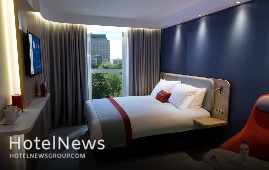
IHG Hotels & Resorts, one of the world’s leading hotel companies, has signed a franchised agreement with Borealis Hotel Group to open Holiday Inn Express Rome – Airport. Planned to open in 2023, the 224-room hotel will add a simple and smart option for travellers on the go by providing the perfect place to rest, relax and recharge, whether for business or leisure. The project will be developed in Parco Leonardo by Fonte (Leonardo Caltagirone Group), one of Italy’s largest developers, and will showcase the fresh and contemporary style of the brand’s Next Generation design, a first for the Holiday Inn Express brand in Italy. This agreement builds growth momentum for IHG Hotels & Resorts in Italy and follows the recent signings and openings of airport locations for the Holiday Inn Express brand across Europe. Holiday Inn Express Rome – Airport brings a new and refreshed offering to visitors; whether travelling for business or leisure. Created with guest comforts in mind, the Next Generation design rooms offer more where it matters most – free Wi-Fi, powerful showers, comfortable beds and added extras for a great night’s sleep. All Holiday Inn Express hotels also offer an Express Start breakfast included as standard. The location of the hotel offers convenient access to Fiumicino Rome International Airport, which is currently undergoing a multi-billon development. Situated in the Parco Leonardo shopping and business centre with a dedicated metro-train stop, the hotel will be perfectly situated to connect locals and guests alike to the heart of the inner city in just 20 minutes. Various retail outlets, restaurants and bars are near the hotel, creating a truly convenient experience for guests travelling to and from Italy.
Create: Oct 27, 2021 Edit: Oct 27, 2021 International News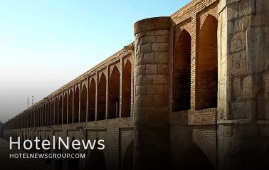
A selection of 200 “untold stories” about Isfahan is now available for you to re-discover the ancient city, which has long been nicknamed as “half the world”. Each story is narrated within a one-minute video clip in different languages to make culture lovers and avid travelers familiar with the off-the-beaten tracks, lesser-known destinations, souvenirs, foods, traditions, rituals, cultural heritage, handicrafts, and above all the hospitable people of Isfahan. Directed by Iranian globetrotter and researcher Majid Erfanian, the clips have been produced jointly by Isfahan Chamber of Commerce, Industries, Mines and Agriculture (ICCIMA), and the private company of Rah Abrisham Iranian Zamin. 100 of the videos, containing 100 fascinating stories, had already been uploaded to social media outlets, while the others were unveiled in an official ceremony hosted by the ICCIMA on Saturday evening. The event was attended by the deputy tourism minister Ali-Asghar Shalbafian, Isfahan governor-general Seyyed Reza Mortazavi, the mayor of Isfahan Ali Qasemzadeh, and Alireza Salarian, the head of Representative Office of Ministry of Foreign Affairs in Isfahan as well as a host of travel insiders, reporters, and journalists who discussed ways to jumpstart tourism. Erfanian stressed the need for greater public awareness about the cultural heritage of the ancient land, saying the “untold stories” are produced for that purpose. “Redefining destinations has rarely happened in the field of traveling [in the country], and now the city [of Isfahan] is a forerunner of such a trend to express its tourism brand in a new way,” he said. Talking about the clips, Erfanian said” “In these multi-language videos, we have tried to put the spotlight on inaccessible or lesser-known historical sites, foods, intangible heritage, people…. characters, craftsmen and figures who have played a role in shaping the identity of Isfahan.” “Sister cities of Isfahan, the diversity of religions, and intangible heritage are amongst other elements we have addressed in the videos,” he added. In an address to the unveiling ceremony, the deputy tourism minister used the context of modern architecture to discuss ways to highlight contemporary Isfahan shoulder to shoulder with its historical core. “We see in the videos that they mostly bring centuries-old architecture and culture into focus, however, we should consider casting a new light on the modern side of Isfahan as well.” “In the production of extra videos, newer ideas may be added to improve the quality of the work,” Shalbafian added. The governor-general of Isfahan reminded the attendees of the unique feature of stories and narratives, in general, to preserve cultural heritage for the coming generations. “In all over the world, paying attention to stories and narratives is of special importance for the development of tourism….. and we have many of such stories that have been forgotten in the course of history.” What you have done in this project is to revive such stories and distinct identities that if ignored, will lead to their disappearance, Mortazavi explained. Ali Karbasizadeh, a senior advisor to the ICCIMA, expressed the need for paying much more attention to the tourism industry, content production, training of all stakeholders and activists, conducting relevant studies, productive investments, tourism startups, and further cooperation with other provinces to develop the tourism paradigm of the country. Furthermore, Karbasizadeh discussed the advantage of adequate official holidays in Iran, saying the number of national holidays in Iran, which has a pivotal role in domestic tourism, is currently insufficient in comparison to many other countries. “If this issue is not addressed and solved, our efforts in other areas would not have desired results.” Salarian for his part noted that making one-minute videos of Isfahan is a good fit. “When we sent [some of the earliest] clips of the series to our embassies in various countries, they expressed a wish to have them translated into other languages as well….Now I see that this has happened.” “Even the municipality [of Isfahan] has produced a series of professional five-minute videos in ten languages that are well received by the audiences.” “Isfahan is one of the important destinations for the high-ranking Iranian officials and visiting officials from other countries. Therefore, it has a unique stance in the field of tourism that should be taken into account,” the senior diplomat explained. Finally, the mayor of Isfahan outlined the importance of storytelling for the time being and in various fields including tourism, saying: “Story [and storytelling] still works in the present day even in psychiatric discussions, story therapy is a growing concept.” “We are ready to expand cooperation and join hands with other activists in the realm of tourism because Isfahan has enormous potential to become a major destination for international travelers,” Qasemzadeh said. Half the world? Soaked in a rich history, Isfahan was once a crossroad of international trade and diplomacy in Iran and now it is one of Iran’s top tourist destinations for good reasons. It is filled with many architectural wonders such as unmatched Islamic buildings, bazaars, museums, Persian gardens, and tree-lined boulevards. It's a city for walking, getting lost in its mazing bazaars, dozing in beautiful gardens, and meeting people. Isfahan is renowned not only for the abundance of great historical bridges but also for its ‘life-giving river’, the Zayandeh-Rood, which has long bestowed the city an original beauty and fertility. Isfahan has long been nicknamed as Nesf-e-Jahan which is translated into “half the world”; meaning seeing it is relevant to see half the world. In its heyday, it was also one of the largest cities in the region with a population of nearly one million. The cool blue tiles of Isfahan's Islamic buildings, and the city's majestic bridges, contrast perfectly with the encircling hot, dry Iranian countryside. The huge Imam Square, best known as Naghsh-e Jahan Sq. (literary meaning “Image of the World”), is one of the largest in the world (500m by 160m), and a majestic example of town planning. Constructed in the early 17th century, the UNESCO-registered square is punctuated with the most interesting sights in Isfahan. It was laid out under the reign of the Safavid ruler, Shah Abbas the Great, to signal the importance of Isfahan as the capital of his powerful empire. It is hemmed on four sides by magnificent buildings: to the east, the Sheikh Lotfollah Mosque; to the west, the palace of Ali Qapu; to the north, the portico of Qeysarieh; and to the south, the eminent Imam Mosque. “The square was at the heart of the Safavid capital’s culture, economy, religion, social power, government, and politics. Its vast sandy esplanade was used for celebrations, promenades, and public executions, for playing polo and for assembling troops,” according to the UNESCO website. Right at the northern limit of the Imam Square, one will find “Qeysarieh Gate”, which leads to the unique and unforgettable “Grand Bazaar of Isfahan”. This vaulted marketplace is one of the largest and most labyrinthine bazaars in the country. Shops offering handicrafts, souvenirs, jewelry, silverware, traditional ceramics, and authentic Persian carpets. Modern Isfahan is now home to some heavy industry, including steel factories and a nuclear facility on its outskirts, however, its inner core wants to be preserved as a priceless gem. The city is also home to a gigantic, professional, and state-of-the-art healthcare city, which is a major destination in the realm of medical tourism. Unknown destination Even before the pandemic, Iran’s tourism was already grappling with some challenges, on top of those Western “media propaganda” aimed at scaring potential travelers away from the Islamic Republic. Some experts believe Iran is still somehow “unknown” for many potential travelers due to such a “media war”. They, however, consider bright prospects for the tourism sector of the country if it vigorously pursues comprehensive strategies to counter U.S.-led propaganda and strict sanctions, yet does its best to loosen tough travel regulations.
Create: Oct 26, 2021 Edit: Oct 27, 2021 Regional News
Radisson Collection, Radisson Hotel Group’s anthology of iconic lifestyle hotels, has continued to expand its portfolio in China with the launch of Radisson Collection Hotel, Wuxi, a stylish and sophisticated new downtown hotel that puts guests in the heart of one of China’s most compelling cities. Newly opened on 22 October 2021, Radisson Collection Hotel, Wuxi is nestled in the city’s Xishan district, just 20 minutes’ drive from Sunan Shuofang International Airport and 15 minutes from Wuxi Railway Station. From this prime location, visitors can uncover the soul of this waterfront city, which sits on the banks of Lake Taihu. Peaceful parks, waterfront walkways and enchanting temples are juxtaposed with a modern metropolis of soaring skyscrapers and high-tech business parks, making Wuxi a highly rewarding destination for business and leisure travelers alike. Guests can stay in a choice of 318 spacious rooms or suites, ranging from the 40 sqm Collection Superior Rooms to the spectacular 258 sqm Presidential Suite, all featuring sleep-inducing beds, working areas, Nespresso coffee machines, fast Wi-Fi and smart bathroom fixtures. The Executive Lounge provides exclusive services and amenities on the 27th floor, overlooking the skyline. Radisson Collection Hotel, Wuxi will also be the first to offer the brand’s new wellness concept, The Spa at Radisson Collection, which is designed to help guests achieve a better version of themselves. This immersive approach focuses on three areas – mood, mind and interaction – for holistic health and wellbeing. The hotel’s serene spa comprises massage and yoga spaces, a sauna and an indoor swimming pool with stunning views. Impressive dining and social experiences can be enjoyed at a choice of five restaurants and bars, including an all-day dining restaurant Maillard 69, the first 3D immersive restaurant in Wuxi; Lan Ting Ge, the Chinese restaurant that specializes in authentic Huai Yang cuisine; Ji Bai Qiu, the contemporary Japanese restaurant; and a whisky bar, Elaresanse. Meeting planners can host talk-of-the-town events in 2,400 sqm of flexible function venue space, including an 800-guest Grand Ballroom. Every stay will be underpinned by Radisson Collection’s unique “Yes, I Can!” service philosophy and the fine Chinese hospitality. I am delighted to unveil Radisson Collection Hotel, Wuxi, as we continue to expand this exceptional collection across China. Following recent openings in Shanghai and Nanjing, this chic hotel represents another major milestone in our development. China is now home to five Radisson Collection hotels, more than any other country, which shows how Chinese owners and guests have embraced this flexible, locally-influenced concept,” said Gary Ye, Vice President, Operations, China, Radisson Hotel Group. Radisson Collection Hotel, Wuxi is a sleek and stylish hotel that exudes the grace of this lakeside city. With our spacious accommodation, five-star facilities and extensive event space, and we expect to become the destination-of-choice for experience-seeking leisure visitors, business travelers, corporate events and one-of-a-kind weddings. We look forward to welcoming the world to Wuxi,” commented Mike Zhang, Resident Manager, Radisson Collection Hotel, Wuxi. One of the largest cities in Jiangsu province, Wuxi is located just 125 km from Shanghai and directly connected to this major metropolis by bullet train. Radisson Collection Hotel, Wuxi becomes the fifth Radisson Collection hotel in China, as this captivating brand continues to inspire guests across the country. It also marks Radisson Hotel Group’s second property in Wuxi, following Radisson Blu Resort Wetland Park Wuxi.
Create: Oct 25, 2021 Edit: Oct 25, 2021 International News
